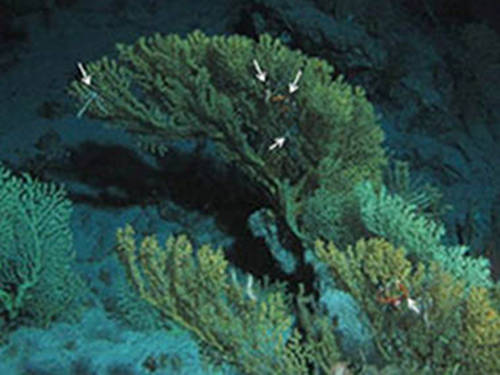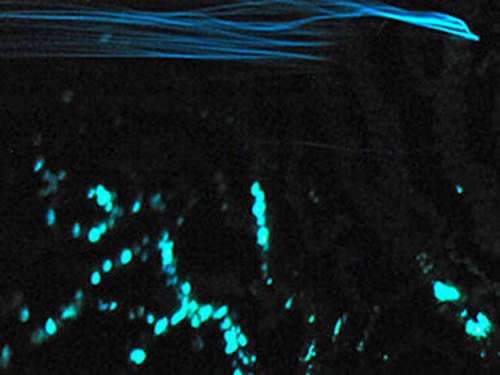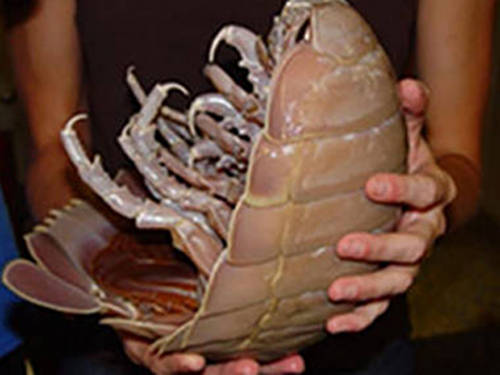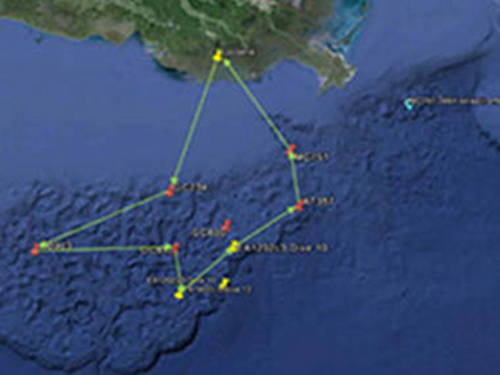
By Tamara Frank - Halmos College of Natural Sciences and Oceanography, Nova Southeastern University

Figure 1. In situ image taken under white light from the Johnson-Sea-Link submersible. Bioluminescent gold coral (formerly Gerardia sp.) occupied by crabs (arrows). Image courtesy of Bioluminescence 2009 Expedition, NOAA/OER. Download image (jpg, 34 KB).
In 2009, on an expedition funded by the NOAA Office of Ocean Exploration and Research (OER) to the Bahamas, we explored the deep-sea benthic environment and looked for new sources of bioluminescence.
Bioluminescence is biologically produced light. While it is relatively rare on land, it is very common in the oceans, at least in the pelagic zone (the water column), where 80 percent of the animals that live between 200 and 1000 meters are bioluminescent.
We were expecting similar results from the benthic zone (the ocean bottom), and were surprised to find that fewer than 20 percent of the species that we collected from the bottom were bioluminescent. However, this was the first systematic survey of bioluminescence in deep-sea benthic species, so this lack of bioluminescence may be specific to this location, and not a universal phenomenon.
In order to see whether benthic bioluminescence really is that much more rare than pelagic bioluminescence, on this 2015 expedition we are going to do similar studies at several sites in a completely different location – the Gulf of Mexico.

Figure 2. In situ image of blue-green bioluminescence of gold coral together with blue bioluminescence from a planktonic animal striking the fan (streak at top). Water current is passing from right to left. Taken with Nikon D700 (f1.8 at ISO 6400), 10 sec. Image courtesy of Bioluminescence 2009 Expedition, NOAA/OER. Download image (jpg, 46 KB).
During our 2009 explorations, we also discovered that the majority of the bioluminescence of the benthic animals was greener than that produced by pelagic species, and that this may hold the answer as to why several species of deep-sea crabs have two visual pigments. While most deep-sea animals have a single, blue-sensitive visual pigment, on previous OER-funded expeditions, we discovered two species of squat lobsters that have both a blue-green and a violet-blue visual pigment. We observed these crabs sitting up in the bioluminescent cnidarians (black and bamboo corals, colonial anemones, and gorgonians, which look like trees sprouting up from the ocean floor), occasionally picking something off the surface of these structures (Figure 1).
We also observed, in complete darkness, that water currents were stimulating the cnidarians to bioluminesce with their usual bluish-green glow, while small plankton that were being driven into these oceanic “trees” were giving off their own blue bioluminescence (Figure 1). This led to the tantalizing hypothesis that the crabs with two visual pigments were “color-coding” their food; i.e., they liked to eat the delicious plankton that was sticking to the cnidarians (like insects in trees), but weren’t interested in eating the cnidarians (or trees) themselves.
In order to see whether this is a viable hypothesis, we need to study the visual systems of a lot more crabs that hang out in these oceanic “trees,” as well as study the color of a lot more species of “trees,” all of which we can do at our study sites in the Gulf of Mexico.

Figure 3. Bathynomus giganteus. Image courtesy of Bioluminescence 2009 Expedition, NOAA/OER. Download image (jpg, 48 KB).
Last, but not least, based on data from previous cruises (Operation Deep Scope III), we know that the eyes of some deep-sea isopods (they look like big roly-polys or pillbugs – some of them are over a foot long!) work like a camera with a very, very slow shutter speed (Figure 3). This makes their eyes extremely sensitive to light, but also makes it very difficult to track moving prey.
These isopods are scavengers, often eating decaying stuff (detritus) on the ocean floor that has fallen from surface waters, like fish carcasses. Other scientists have hypothesized that as the detritus falls through the water, it is being colonized by bioluminescent bacteria, so areas of the ocean floor where currents are minimal may be covered with mats of dimly glowing detritus.
Our hypothesis is that scavengers with big, slow eyes like the isopods may be able to see this glow (which is too dim for our eyes to see). With some of the technology available to us on this cruise, we’re going to go to a region with minimal bottom currents and photograph some of these mats in complete darkness using very long exposure times. We’re also hoping to study the visual systems of other species of scavengers with big eyes that are found there, to determine if slow eyes are a common adaptation in these kinds of scavengers.

Figure 4. Exploration sites for 2015 in the Gulf of Mexico. Image courtesy of the Bioluminescence and Vision on the Deep Seafloor 2015 expedition. Download image (jpg, 41 KB).
We’ll be using our combined expertise in bioluminescence, taxonomy, visual ecology, imaging, and molecular biology, together with the unique collecting capabilities and camera systems of the remotely operated vehicle, the Global Explorer, to continue our studies of the deep-sea benthic environment in the Gulf of Mexico.
Leaving from Cocodrie, Louisiana, we’ll be visiting sites with lush populations of cnidarians and crustaceans, hydrocarbon seep sites with fewer corals, but an abundance of bacterial mats, and some muddy bottom areas with minimal currents where Bathynomus have been observed. Sites 2-6 are deeper than 1000 meters deep, while sites 1 and 7 have a bottom depth of around 500 meters, allowing us to compare the diversity and abundance of bioluminescent animals at shallower versus deeper sites as well.